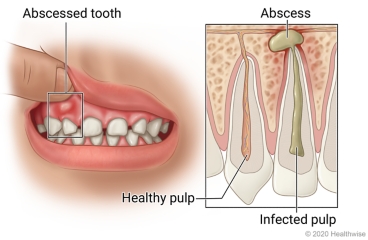
Overview
An abscessed tooth is a tooth that has a pocket of pus in the tissues around it. Pus forms when the body tries to fight an infection caused by bacteria. If the pus cannot drain, it forms an abscess. An abscessed tooth can cause red, swollen gums and throbbing pain, especially when your child chews. Your child may have a bad taste in their mouth and a fever, and your child's jaw may swell.
Damage to the tooth, untreated tooth decay, or gum disease can cause an abscessed tooth.
An abscessed tooth needs to be treated by a dental professional right away. If it is not treated, the infection could spread to other parts of your child's body. A dentist will give your child antibiotics to stop the infection. If antibiotics don't stop the infection, your child may need other treatments.
Follow-up care is a key part of your child's treatment and safety. Be sure to make and go to all appointments, and call your doctor if your child is having problems. It's also a good idea to know your child's test results and keep a list of the medicines your child takes.
How can you care for your child at home?
- Help your child brush and floss gently.
- Reduce pain and swelling in your child's face and jaw by putting ice or a cold pack on the outside of your child's cheek for 10 to 20 minutes at a time. Put a thin cloth between the ice and your child's skin.
- Be safe with medicines. Give pain medicines exactly as directed.
- If the doctor gave your child a prescription medicine for pain, give it as prescribed.
- If your child is not taking a prescription pain medicine, ask your doctor if your child can take an over-the-counter medicine such as acetaminophen (Tylenol) or ibuprofen (Advil, Motrin). Be safe with medicines. Read and follow all instructions on the label.
- Give your child antibiotics as directed. Do not stop using them just because your child feels better. Your child needs to take the full course of antibiotics.
When should you call for help?
Call 911 anytime you think your child may need emergency care. For example, call if:
- Your child has trouble breathing.
Call your doctor now or seek immediate medical care if:
- Your child has new or worse symptoms of infection, such as:
- Increased pain, swelling, warmth, or redness.
- Red streaks leading from the area.
- Pus draining from the area.
- A fever.
Watch closely for changes in your child's health, and be sure to contact your doctor if:
- Your child does not get better as expected.
Where can you learn more?
Go to http://www.healthwise.net/patientEd
Enter R932 in the search box to learn more about "Abscessed Tooth in Children: Care Instructions".
Current as of: September 30, 2025
Author: Ignite Healthwise, LLC Staff
Clinical Review Board
All Ignite Healthwise, LLC education is reviewed by a team that includes physicians, nurses, advanced practitioners, registered dieticians, and other healthcare professionals.

